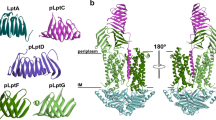Abstract
Herein are reported the mainchain 1H, 13C and 15N chemical shift assignments and amide 15N relaxation data for Escherichia coli DmsD, a 23.3 kDa protein responsible for the correct folding and translocation of the dimethyl sulfoxide reductase enzyme complex. In addition, the observed amide chemical shift perturbations resulting from complex formation with the reductase subunit DmsA leader peptide support a model in which the 44 residue peptide makes extensive contacts across the surface of the DmsD protein.


Similar content being viewed by others
References
Berks BC (1996) A common export pathway for proteins binding complex redox cofactors? Mol Microbiol 22:393–404
Buchanan G, Maillard J, Nabuurs SB, Richardson DJ, Palmer T, Sargent F (2008) Features of a twin-arginine signal peptide required for recognition by a Tat proofreading chaperone. FEBS Lett 582:3979–3984
Chan CS, Winstone TML, Chang L, Stevens CM, Workentine ML, Li H, Wei Y, Ondrechen MJ, Paetzel M, Turner RJ (2008) Identification of residues in DmsD for twin-arginine leader peptide binding, defined through random and bioinformatics-directed mutagenesis. Biochemistry 47:2749–2759
Chen S, Fan Y, Shen X, Sun P, Jiang G, Shen Y, Xue W, Li Y, Chen X (2008) A molecular modeling study of the interaction between SRP-receptor complex and peptide translocon. Biochem Biophys Res Commun 377:346–350
Delaglio F, Grzesiek S, Vuister GW, Zhu G, Pfeifer J, Bax A (1995) NMRPipe: a multidimensional spectral processing system based on UNIX pipes. J Biomol NMR 6:277–293
Farrow NA, Muhandiram R, Singer AU, et al (1994) Backbone dynamics of a free and phosphopeptide-complexed Src homology 2 domain studied by 15N NMR relaxation. Biochemistry 33:5984–6003
Genest O, Méjean V, Iobbi-Nivol C (2009) Multiple roles of TorD-like chaperones in the biogenesis of molybdoenzymes. FEMS Microbiol Lett 297:1–9
Goddard TD, Kneller DG (2008) SPARKY. University of California, San Fransisco
Ikura M, Bax A, Clore GM, Gronenborn AM (1990) Detection of nuclear Overhauser effects between degenerate amide proton resonances by heteronuclear three-dimensional NMR spectroscopy. J Am Chem Soc 112(24):9020–9022
Lee PA, Tullman-Ercek D, Georgiou G (2006) The bacterial twin-arginine translocation pathway. Annu Rev Microbiol 60:373–395
Marsh JA, Singh VK, Jia Z, Forman-Kay JD (2006) Sensitivity of secondary structure propensities to sequence differences between alpha- and gamma-synuclein: implications for fibrillation. Protein Sci 15:2795–2804
Oresnik IJ, Ladner CL, Turner RJ (2001) Identification of a twin-arginine leader-binding protein. Mol Microbiol 40:323–331
Pommier J, Méjean V, Giordano G, Iobbi-Nivol C (1998) TorD, a cytoplasmic chaperone that interacts with the unfolded trimethylamine N-oxide reductase enzyme (TorA) in Escherichia coli. J Biol Chem 273:16615–16620
Ramasamy SK, Clemons WM (2009) Structure of the twin-arginine signal-binding protein DmsD from Escherichia coli. Acta Crystallogr Sect F 65:746–750
Sattler M, Schleucher J, Griesinger C (1999) Heteronuclear multidimensional NMR experiments for the structure determination of proteins in solution employing pulsed field gradients. Prog Nucl Magn Reson Spectrosc 34:93–158
Shen Y, Bax A (2012) Identification of helix capping and b-turn motifs from NMR chemical shifts. J Biomol NMR 52(3):211–232
Stevens CM, Paetzel M (2012) Purification of a Tat leader peptide by co-expression with its chaperone. Protein Expr Purif 84(1):167–172
Stevens CM, Winstone TML, Turner RJ, Paetzel M (2009) Structural analysis of a monomeric form of the twin-arginine leader peptide binding chaperone Escherichia coli DmsD. J Mol Biol 389:124–133
Tranier S, Iobbi-Nivol C, Birck C, Ilbert M, Mortier-Barrière I, Méjean V, Samama J-P (2003) A novel protein fold and extreme domain swapping in the dimeric TorD chaperone from Shewanella massilia. Structure 11:165–174
Turner RJ, Papish AL, Sargent F (2004) Sequence analysis of bacterial redox enzyme maturation proteins (REMPs). Can J Microbiol 50:225–238
Weiner JH, Bilous PT, Shaw GM, Lubitz SP, Frost L, Thomas GH, Cole JA, Turner RJ (1998) A novel and ubiquitous system for membrane targeting and secretion of cofactor-containing proteins. Cell 93:93–101
Winstone TL, Workentine ML, Sarfo KJ, Binding AJ, Haslam BD, Turner RJ (2006) Physical nature of signal peptide binding to DmsD. Arch Biochem Biophys 455:89–97
Acknowledgments
The authors would like to acknowledge Eric Escobar, Hyun-Seo Kang and Kelly Kim for assistance with Sparky and assignment techniques and Dr. R. J. Turner for providing the plasmid from which our DmsD construct was cloned. NMR instrument support was provided by the Canadian Institutes for Health Research (CIHR), the Canadian Foundation for Innovation (CFI), the British Columbia Knowledge Development Fund (BCKDF), the UBC Blusson Fund, and the Michael Smith Foundation for Health Research (MSFHR). M. P. acknowledges funding from the National Science and Engineering Research Council of Canada (NSERC), CIHR and MSFHR. L. M. acknowledges funding from NSERC.
Author information
Authors and Affiliations
Corresponding authors
Rights and permissions
About this article
Cite this article
Stevens, C.M., Okon, M., McIntosh, L.P. et al. 1H, 13C and 15N resonance assignments and peptide binding site chemical shift perturbation mapping for the Escherichia coli redox enzyme chaperone DmsD. Biomol NMR Assign 7, 193–197 (2013). https://doi.org/10.1007/s12104-012-9408-8
Received:
Accepted:
Published:
Issue Date:
DOI: https://doi.org/10.1007/s12104-012-9408-8




